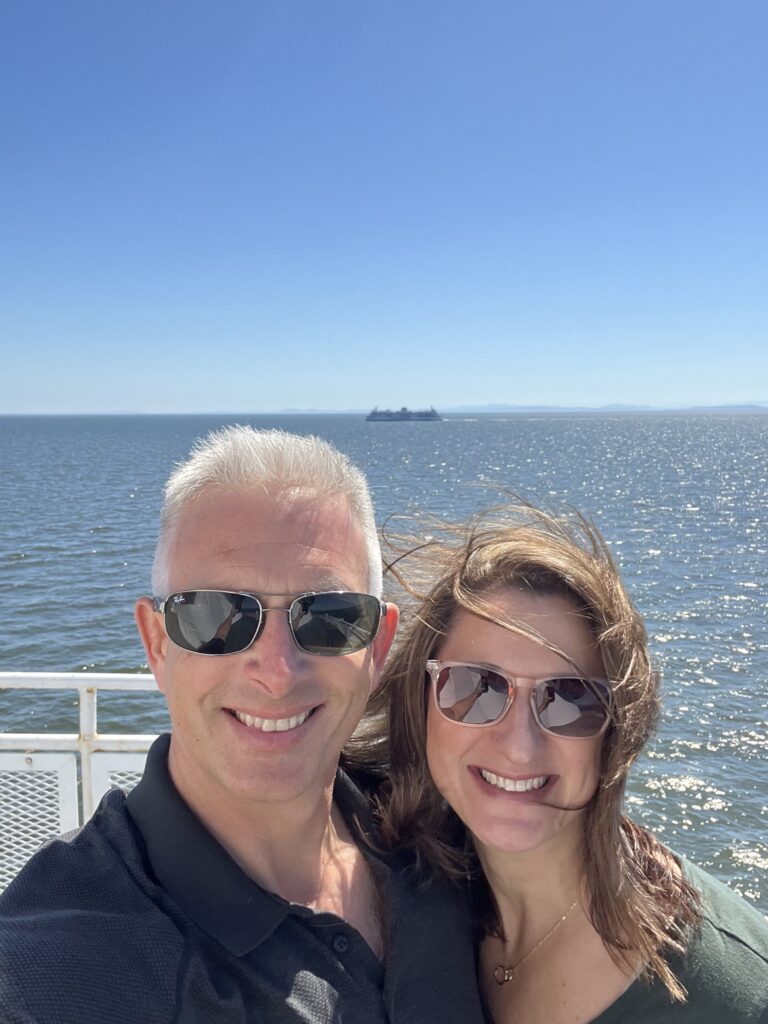Happy May! So nice to get a beautiful spring weekend here in the lower mainland. My youngest son, Jordan, had a soccer game over in Nanaimo on Saturday. Great day for an Island road trip. Pretty fortunate to live in such a beautiful part of the world that a boat trip on the ocean with snow-covered mountains in the backdrop is just a routine “away game” commute! A fun day too, as Nanaimo did a really nice job promoting the game and had over 1000 fans out. Spring is always a confusing time weather wise. Whistler got 100cms of snow over Easter Weekend. I had my best ski day of the year two weeks ago. This week I was in shorts and a t shirt on the ferry ride over to Nanaimo!


Markets are confused right now too! They are trying to make sense of a bunch of contradictory data indicators.
Inflation numbers dropping significantly has paused interest rate hikes, and the hard data shows that actual economic performance remains strong. While employment and retail spending metrics are good, soft data has many businesses and consumers bracing for one of the most anticipated recessions on record.
Banking turmoil in the US is at the top of the news cycle. Silicon Valley Bank (SVB) went into bankruptcy protection in March, bringing back memories of 2008. SVB specializes in relationships with tech startups and venture capital firms. 2020 was a spectacular year of growth for them, with their deposits increasing exponentially. Using those customer deposits, the bank invested billions of dollars in bonds over the last few years. These would be pretty conservative investments and well within the standard operating procedure for any bank. But 2022 brought the double whammy of the tech sector crashing and interest rates aggressively raised as governments fought inflation. Those bonds became underwater and SVB tried to refinance at a time when their customers (tech companies and startups) were burning cash. As word got out of their difficulties, more and more of its clients started pulling their money. This precipitated a good old-fashioned run on the bank and caused it to fail. Every single bank out there has a portion of its assets in a similar predicament. 2022 was not a kind year for investments, but that wouldn’t matter to most people if you aren’t using the money in 2023.
The main problem with SVB is its customer base was so concentrated in one sector. It’s kind of in the name – Silicon Valley Bank! Their slogan might as well have been “the high risk lender for high risk companies.” It’s one thing to have a portion of your client base be startups in a down market; it’s another when you specialize in it. There has been a bit of contagion in other banks as most have some part of their portfolio in similar assets. So far, the US government has backed investments and allowed some of the better diversified and more predatory financial institutions to swoop in and buy up those banks whose asset base is shaky. It’s a pretty important reminder of the importance of diversification!
I am watching the sector carefully, but the circumstances around SVB seem relatively singular, and I will be surprised if it stays in the news cycle for too much longer. This is an “exploit the opportunity” rather than a “need to solve a problem” scenario.
I am more interested in what happens on the corporate real estate side over the next year when commercial borrowers must refinance at higher rates on properties with 65% occupancy instead of 100%. These headlines worry investors, and markets are currently in a holding pattern despite the stronger than expected economy. TSX is up 6%, and the US market is up 8% so far this year. When you have such opposing data to try and evaluate, it is tough for markets to commit to a direction.
I turned 50 in March.
Those milestone birthdays are certainly a time for reflection. I play in a summer rec league soccer with my sons. My oldest son, Jacob, started playing with me ten years ago when he was 15, and I was still pretty good. He still attributes part of his growth as a player to playing men’s league early and getting some on-field “coaching” while playing with me. My daughter, Maddie, two years younger, would come watch the games and delight in “coaching” me from the stands. I had to explain to many an opponent that the loudmouth girl on the sidelines was yelling at me, not them.
Jordan is six years younger than Jacob and just started playing men’s soccer a couple years ago. He says he can’t even remember a time when I was good! There is no coaching either way – all I get from him is trash talk!
I’m a bit sad about turning 50. While I can somewhat accept that my glory days of athletic excellence are behind me, I was really hoping that as my body deteriorates, I’d at least feel wise by this age! Unfortunately, my business is one that I feel continues to find new ways to make fools of us all!
I’m part of the Worldsource advisory council, and over the years, I have enjoyed getting together with some of the top advisors across the country and listening to and learning from some of the smartest guys in the business. I just returned from Toronto two weeks ago from this year’s conference. Someone must have heard about my birthday and assumed that now that I am 50, I know what I am doing, as I was asked to speak at the conference this year.
I am fascinated by numbers and stats, not just in markets and sports, but also in their application to day-to-day living.
The 100-hour rule claims that spending 100 hours of dedicated study on one subject or endeavour will put you ahead of 95% of the general population in that area of expertise. I built my practice around this philosophy in that I did a lot of seminars in my younger years, secure in the knowledge that while I wasn’t yet a master of money management, I did know more about markets and investing than the average person.
It’s a bit different when speaking to other professionals in your field. Malcolm Gladwell popularized the 10,000 hours rule. It claims that to master anything in life, you must dedicate 10,000 hours of intentional practice to the area. You don’t have to be a math expert to realize that is a more significant commitment than 100 hours! When I first got asked to speak, I wondered if they had run out of people to ask. Then I did the math. Ten thousand hours works out to 90 minutes a day for 20 years. I dedicate the first 90 minutes of my day to research and reading and have been doing that for the 25 years I have been in this business.
Technically I do meet the definition of an expert! There is no real tipping point for meeting that definition, so I coasted on into that category somewhere over the years without realizing it! I have also been married for 27 years and have never heard Kristy refer to me as an expert husband, so this research may have some flaws!
When COVID hit, and I started working out of my home, I spent some time picking out live plants for my office. I wanted to get a Bonsai tree, but my wife said I had to prove I could take care of a regular plant before spending the money on a Bonsai (they are much more expensive than I thought!). We bought a sort of root ball plant that was supposed to be easy to take care of, as well as a few others. Almost all the real plants have been replaced with fakes three years later. I am determinedly hoping to resuscitate my root ball plant to prove worthy of a real Bonsai, but the prognosis is not looking good. I am still a long way from mastering botany!

I spend a lot more time researching and reading about markets than I do about plants, yet they often leave me just as frustrated as my failed gardening skills.
I genuinely feel I am no better at predicting markets today than I was when I started this business. GDP, earnings, unemployment, and inflation all require extensive study to understand, and even if you manage to get those right, you have to overlay government policy, macroeconomics, and the psychology of how investors are feeling to arrive at a correct prognostication. I can tell you that markets are probably going to average between 7-10% over the next couple of decades. Still, if I had given you that prediction at the beginning of every year of my life for your expected annual rate of return, I would only have been correct twice in the last 50 years!
The one thing I have improved with age is understanding what is important and what is not. The older I get the more I add to the list of things that are inconsequential.
Markets, on a day-to-day basis, don’t matter. Trust always matters. Politics don’t matter. Discipline, strategy, and an investment process do. Making mistakes is inevitable; limiting the scope of those mistakes is what is important. Your annual rate of return doesn’t matter; matching your portfolio requirement with your objectives over the long term is crucial. Stay current but understand that headline news is mostly just noise. Read them to look for opportunities rather than problems. Diversification and durability matter. Don’t be afraid of innovation, but don’t complicate things where simple works. Conviction is important, but zealotry is dangerous. You can be adaptable in your investment choices but must be rigid in your investment principles.
Not sure it is actually wisdom, but these are the things I know to be true. It is liberating to admit that I can’t predict where markets are going day to day so that I can focus on refining my investment process. I stay informed and read as much as I can on inflation, interest rates, banking, and the economy, but I don’t let headlines determine my actions. Invest regularly with discipline, diversification, and commitment to a long-term strategy, and you will meet your financial goals regardless of what is going on with markets at any given moment in time. I am hopeful, but somewhat skeptical, that you will ever see a real Bonsai tree in my office, but I am confident that the portfolios we are building will withstand the test of time!
Stay disciplined, be optimistic!
The information provided here is general in nature and should not be considered personal investment advice or solicitation to buy or sell any securities. It may include information concerning financial markets as at particular point in time and is subject to change without notice. Every effort has been made to compile it from reliable sources, however, no warranty can be made as to its accuracy or completeness. The views expressed here are those of the authors and writers only and not necessarily those of Worldsource Securities Inc., its employees or affiliates. There may also be projections or other “forward-looking statements.” There is significant risk that forward looking statements will not prove to be accurate and actual results, performance or achievements could differ materially from any future results, performance or achievements that may be expressed or implied by such forward-looking statements and you will not unduly rely on such forward-looking statements. Before acting on any of the information provided, please contact your advisor for individual financial advice based on your personal circumstances.
Worldsource Securities Inc., is the sponsoring investment dealer and the member of Investment Industry Regulatory Organization of Canada and the Canadian Investor Protection Fund.

leave a comment